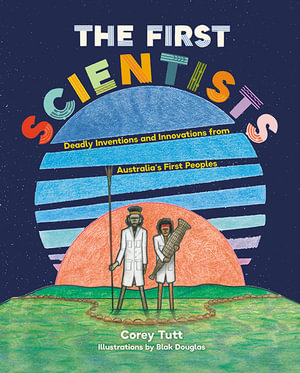
Title
The First Scientists : Deadly Inventions and Innovations from Australia’s First People
Author
Corey Tutt
Illustrators
Blak Douglas
Publisher, Date
Hardy Grant Explore, 2021
Audience
5-8yrs, Lower Primary, Primary, Upper Primary
ISBN
9781741177527
Language
English
Add to Favourites
-
Subjects
- Agriculture
- Animals
- Art, Aboriginal Australian
- Astronomy
- Canoes and canoeing
- Climate
- Country
- Cultural heroes
- Culture
- Education
- Environmental protection
- Fishing
- Food
- Health
- History
- Hunting and gathering
- Indigenous knowledge
- Land management
- Science
- Tool making
- Tracking
- Traditional ecological knowledge
- Weather
-
Annotation
Today, the practical and scientific value of the traditional cultural and sustainable land management practices of Australia’s First Nations people are becoming increasingly recognised more appropriate even ‘best practice’ in taking care of Australia’s natural environment. For over 65,000 years our First Nations people have worked with the natural environment using the changing signs in the sky, the land and the weather to source food, protect their families and belongings and create tools and objects to make life easier.
‘The First Scientists’ details many of the inventions and innovations developed by the First Nations people that show how their cultural practices were not only finely tuned to living on Country but also advanced in their understanding of their environmental impact. The book highlights how First Nations people have used science to assist in their day-to-day life such as the Central desert Anangu people who create a resin from spinifex grass to glue their tools together.
The book provides information about astronomy, engineering (did you know that the aerodynamic design of the boomerang has been copied and used in the design of modern aeroplane wings?) toolmaking, food, medicine and ecology. We learn that the resins that they created from grasses and other plants for waterproofing are being studied today as replacements for plastics. The animal and land management practices, particularly fire management, are today being acknowledged as a better way to manage and protect our natural environment.
The book provides information about First Nations scientists or innovators who are or have made an important contribution to the advancement of scientific knowledge and care. David Unaipon, for example, is pictured on Australia’s $50 note. A dreamer and inventor, his 1909 invention of a handpiece for sheep shearing revolutionised the industry making shearing faster and easier.
At the back of the book is an extensive list of references that provide additional information. Many of these can be sourced online. The AIATSIS map of Indigenous Australia is included in the front of the book to assist with locations.
Corey Tutt is a proud Kamilaroi man who is passionate about animals and science. In 2018 he founded ‘Deadly Science’ and began helping other children like himself to find a love and passion for science. In 2020 he was named the NSW Young Australian of the Year and a Human Rights hero. Sydney based illustrator, Blak Douglas has a Caucasian mother and an Indigenous father. A Dhungatti man, he is frequently challenged about his ethnicity and adopted the name Blak Douglas to operate in both worlds.
-
Teaching Resources
- DeadlyScience Ltd https://deadlyscience.org.au/
- https://deadlyscience.org.au/ https://www.abc.net.au/news/science/2020-04-12/walking-together-indigenous-science-camp/12066816
- IndigenousX. 11 Nov 2018 by Joe Sambono ‘Indigenous science goes far beyond boomerangs and spears’ https://indigenousx.com.au/indigenous-science-goes-far-beyond-boomerangs-and-spears/
- SBS News 1 Oct 2020 by Rae Johnston ‘Indigenous scientists in the running for the ‘Oscars’ of Australian science’ https://www.sbs.com.au/nitv/article/2020/10/01/indigenous-scientists-running-oscars-australian-science
- National Film and Sound Archive of Australia (NFSA) 25 Jul 2017 ‘My Survival as an Aboriginal (1978) - Tracking animals’ https://www.youtube.com/watch?v=FbxZFfhltAM
- Wildlife Australia, Winter 2019, ‘Reading the Indigenous night sky to interpret wildlife patterns’ http://www.aboriginalastronomy.com.au/wp-content/uploads/2019/06/Leaman-2019-Wildlife-Australia-Magazine.pdf
- ABC Local by Vanessa Mills 2 Feb 2010 ‘Bush tracking skills for conservation science’ https://www.abc.net.au/local/stories/2010/01/29/2805282.htm
